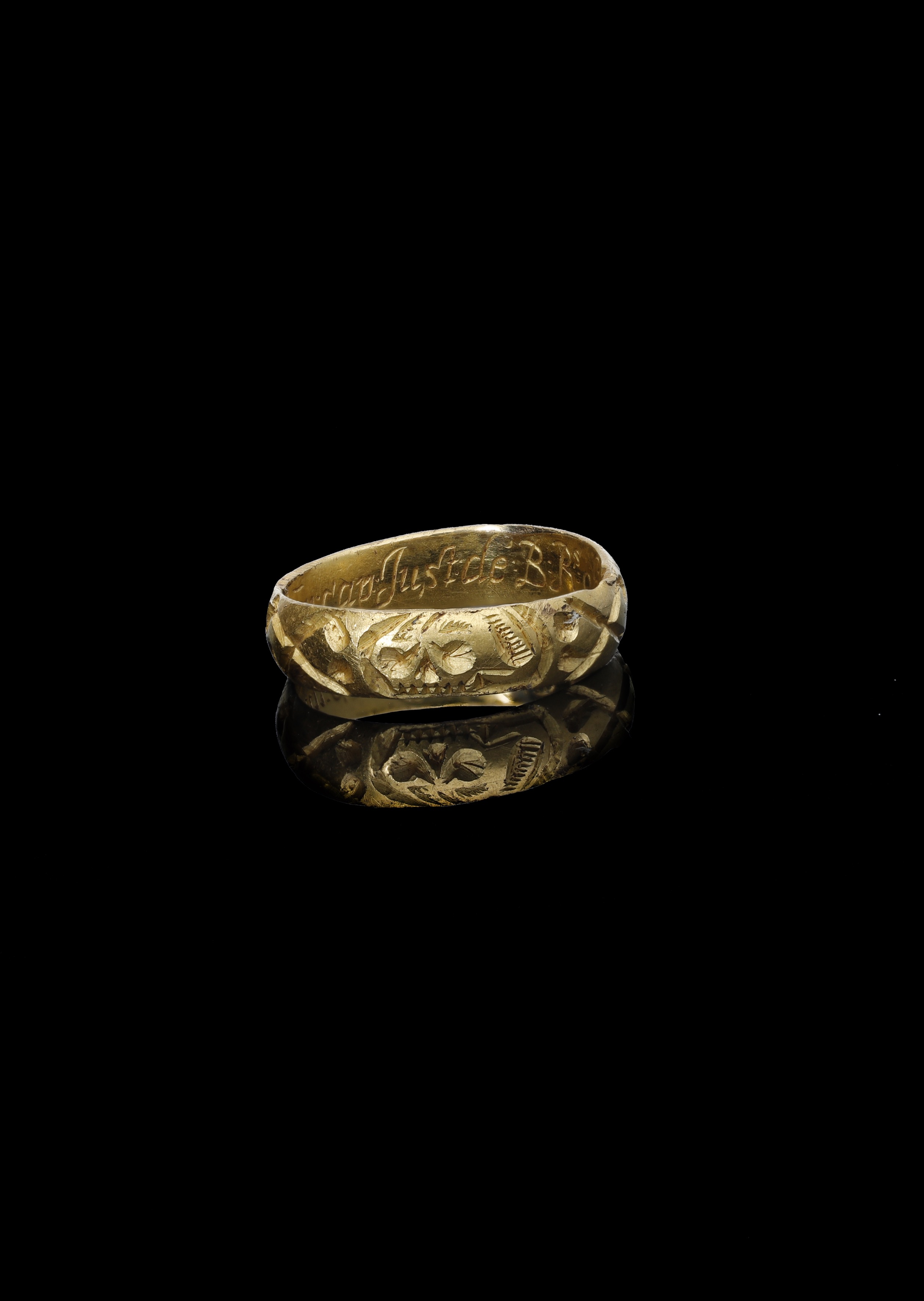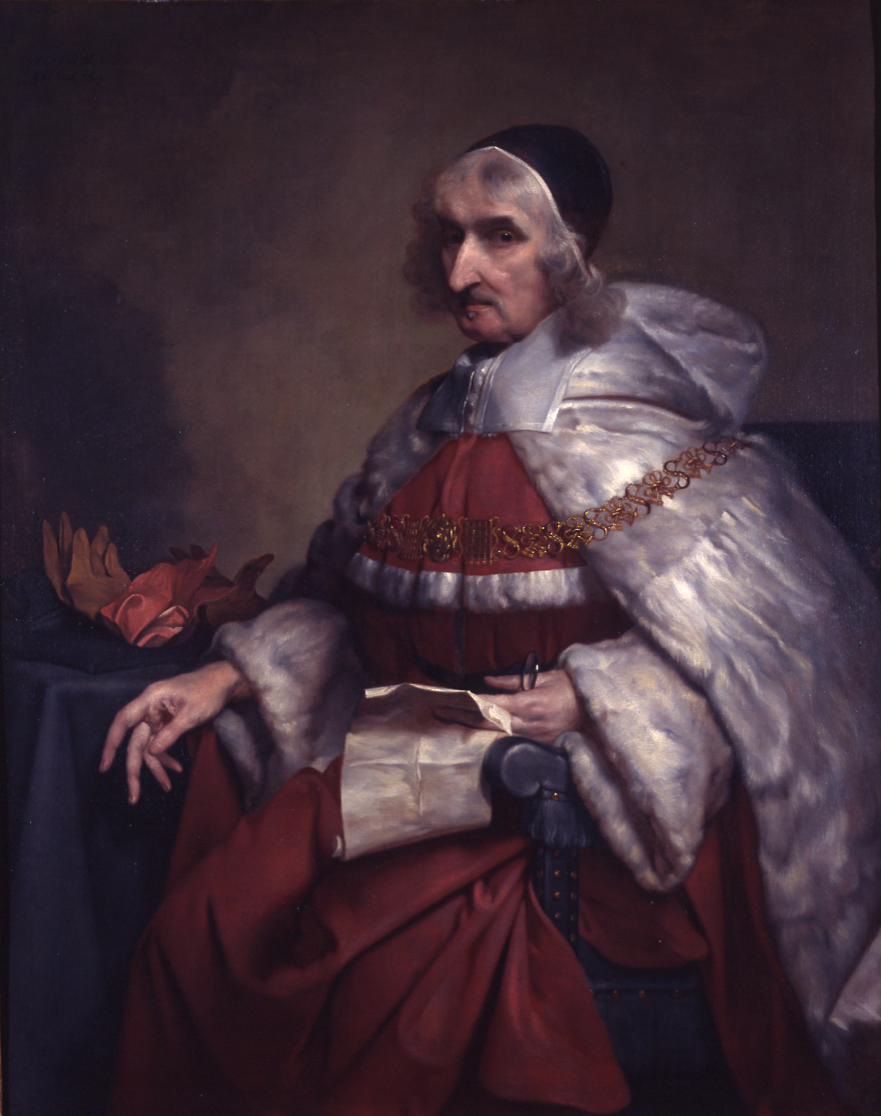THE SIR RICHARD RAYNSFORD MEMORIAL RING A late 17th century memorial ring for Sir Richard Raynsford (Rainsford), the band with engraved skull motif between pairs of crossed bones, the interior inscribed ‘R.R:Mil:nup:c'ap:Ju,st:de:B:Rs:ob:17:Feb:80:cet:76’ in italic script, maker’s mark ‘IG’ over a pellet in shield-shaped punch, band width 4mm, ring size M, weight 3.6gm. £6,000-£8,000 --- Provenance: This ring was discovered by a metal detectorist in the parish of Brafield, Northamptonshire in January 2020. It is recorded on the Portable Antiquities Scheme database, ref: NARC-4A75BB and has been disclaimed as Treasure, ref: 2020-T441. The inscription to the interior reads: ‘Richard Rainsford, Mile Nuper Cap Just De Banco Regis Obitus 17 Feb 80 Æt 76’, translating as: ‘Richard Rainsford, Knight, lately Chief Justice of the Court of the King’s Bench, Died 17th February 1680 aged 76’. Sir Richard Raynsford (Rainsford) (c.1605–1680) was the second son of Robert Raynsford [Rainsford] of Staverton, Northamptonshire and his second wife Mary Kirton. He matriculated at Exeter College, Oxford but left without obtaining a degree. He was knighted by 1622 and called to the bar in October 1632. In 1660 Raynsford was elected MP for Northampton, became Treasurer of Lincoln's Inn and was sworn in as a serjeant-at-law. He was re-elected MP for Northampton in 1661 for the Cavalier Parliament, and in 1663 raised to the bench as Baron of the Exchequer. He presided over the commission to supervise the execution of the Act of Settlement 1662 in Ireland, and on his return to England was raised to the exchequer bench. Following the Great Fire of London in 1666, Raynsford sat as a ‘Court of Fire Judge’ - one of a panel of judges commissioned to address questions concerning landlords, tenants and occupiers of buildings destroyed by the flames. In gratitude for their work, the City of London Corporation commissioned portraits of all Fire Court judges, to be hung in the Guildhall. Raynsford’s Fire Court Judge portrait was painted by John Michael Wright, together with a further portrait by Gilbert Soest (c.1605-1681), (reproduced here by kind permission of the Benchers of the Honourable Society of Lincoln’s Inn), now hanging in the Great Hall at Lincoln’s Inn. In April 1676, Raynsford was appointed Chief Justice of the King's Bench. Raynsford died in 1680 at Dallington Hall, his family seat. In his will, he specified: “unto my sisters-in-laws, Mrs Burkett, Mrs Goldsmith, Mrs Fulham and Mrs Wright, and to my cousins Mrs Wagstaffe, Mrs Barry and Mrs Barnsley forty shillings a piece to buy them rings in remembrance of me”, also, “two further remembrance rings or plates were to be made with twenty pounds set aside” for his three daughters-in-law. The ring offered for sale here is most probably one of these specified rings. Raynsford’s will can be viewed at the National Archive, Kew. (Ref: PROB 11/363/33) The Malmesbury Witch Trials, 1672 Raynsford was the judge in several trials of the Malmesbury Coven, some of the last witch trials held in England. Whilst the early 17th century hysteria about witchcraft had passed, in 1672 the wealthy townsfolk of Malmesbury, Wiltshire, were convinced there was a powerful coven of witches in their midst. Ten women and two men were charged with bewitching and ‘lameing’ a boy named Thomas Webb, whilst the supposed leader Elizabeth Peacock was also accused of murdering four other children by witchcraft. The local court dismissed charges against most of those accused, but Elizabeth Peacock, Judith Witchell, and Ann Tilling were sent to Salisbury to be judged by Sir Richard Raynsford in his next Assizes. Although considered the ringleader, Elizabeth Peacock was acquitted by Raynsford stating that without a confession, there was insufficient evidence to make a conviction. However Judith Witchell and Ann Tilling did confess and both sentenced to death and hanged in 1672. Literature: Notestein, W: A History of Witchcraft in England from 1558 to 1718, pub. 1911. McAleavy, T: The Last Witch Craze: John Aubrey, the Royal Society and the Witches, pub. 2022. Condition Report The surface of the band is a worn/scuffed skull motif and crossed bones to the exterior, well defined and still crisp - no traces of enamel. The inscription is clear and legible and the script attractive. The maker’s mark also clear. There is one nick/scuffing to the sides of the band. Band width 4.2mm. Ring diameter 19mm. The ring has been slightly straightened since discovery. Image: Reproduced by kind permission of the Benchers of the Honourable Society of Lincoln’s Inn.












